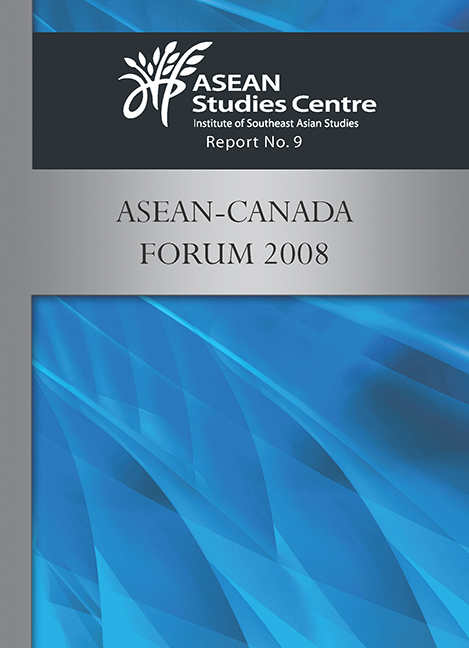Book contents
- Frontmatter
- Dedication
- Contents
- Introduction
- I Regional Economic Integration: ASEAN and Canadian Perspectives
- II Background Papers
- 1 AFTA–NAFTA: Trade and Investment Issues
- 2 Trade and Investment Issues in ASEAN Economic Integration
- 3 Institutional Development in ASEAN
- 4 Governance Issues in NAFTA
- 5 Different Approaches to Dispute Resolution under ASEAN
- 6 Dispute Resolution under NAFTA: Evolution and Stagnation
- 7 Winners and Losers in ASEAN Economic Integration: A Perspective from Vietnam
- 8 Winners and Losers in International Economic Integration: The Distributional Effects of NAFTA
- 9 Cross-border Labour Migration in ASEAN: Issues and Challenges
- 10 Labour Market Integration within NAFTA
- Annex I: Programme of the Forum
- Annex II: List of Participants
- Annex III: Rules-based Governance
9 - Cross-border Labour Migration in ASEAN: Issues and Challenges
from II - Background Papers
Published online by Cambridge University Press: 21 October 2015
- Frontmatter
- Dedication
- Contents
- Introduction
- I Regional Economic Integration: ASEAN and Canadian Perspectives
- II Background Papers
- 1 AFTA–NAFTA: Trade and Investment Issues
- 2 Trade and Investment Issues in ASEAN Economic Integration
- 3 Institutional Development in ASEAN
- 4 Governance Issues in NAFTA
- 5 Different Approaches to Dispute Resolution under ASEAN
- 6 Dispute Resolution under NAFTA: Evolution and Stagnation
- 7 Winners and Losers in ASEAN Economic Integration: A Perspective from Vietnam
- 8 Winners and Losers in International Economic Integration: The Distributional Effects of NAFTA
- 9 Cross-border Labour Migration in ASEAN: Issues and Challenges
- 10 Labour Market Integration within NAFTA
- Annex I: Programme of the Forum
- Annex II: List of Participants
- Annex III: Rules-based Governance
Summary
Introduction
Liberalization of international labour mobility has progressed more slowly than liberalization of flows of goods, services and investments. In the World Trade Organization (WTO), labour mobility is found only in a trade context under trade in services, that is, General Agreement on Trade in Services (GATS) Mode 4 on movement of natural persons. In regional trade arrangements (RTAs) labour mobility is a key feature of the European Union (EU), but in many free trade areas (FTAs) it is restricted to movement of business persons, traders, intra-corporate transferees and professionals.
In the Southeast Asian region, there is restricted immigration and no free movement of labour across countries, although ASEAN countries grant visa-free entry on visitors from fellow member countries. Employment usually requires work permits and employment passes. The early ASEAN agreements — the ASEAN Free Trade Area (trade in goods), ASEAN Framework Agreement of Services (trade in services) and ASEAN Investment Area (investment) — contain no provisions on cross-border labour mobility. However, “free flow of skilled labour” is incorporated in the ASEAN Economic Community (AEC) to be realized by 2015.
International labour migration (ILM) or cross-border labour migration is an increasingly visible phenomenon in Southeast Asia in recent decades. The region is a net exporter of labour to the rest of the world. Major destinations are the Middle East and Northeast Asia (Japan, Taiwan, South Korea and Hong Kong), with smaller flows to the United States, Canada, Europe and Australia. Within Southeast Asia itself, main labour sending countries are Indonesia, the Philippines and Cambodia, Laos, Myanmar, Vietnam (CLMV); main labour receiving countries are Brunei, and Singapore; while Malaysia and Thailand are both labour sending and receiving countries.
This paper seeks to examine the determinants and patterns of ILM and their macro and micro effects on labour-sending and labour-receiving countries in ASEAN as well as the labour migration policies and issues and regional cooperation challenges.
Determinants and Patterns of ILM in Southeast Asia
Southeast Asia has historically been the destination of migration waves from China, India, and the Middle East and these have left strong imprints on the region's demography, society and politics. In the twentieth century, inward migration ended with World War II. In the post-war years, political developments in Southeast Asia have led to controls on cross-border migration inflows (Chia 2008).
- Type
- Chapter
- Information
- ASEAN-Canada Forum 2008 , pp. 195 - 235Publisher: ISEAS–Yusof Ishak InstitutePrint publication year: 2010



